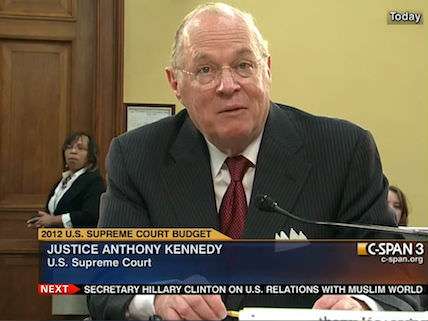Immigration Hardliners Lose Today in an 8-1 Supreme Court Ruling
The ruling also raises questions about the future viability of "Chevron deference."

Today the U.S. Supreme Court ruled 8-1 in favor of an undocumented immigrant seeking to qualify for discretionary relief from federal deportation proceedings. The ruling also raised serious questions about the future viability of a controversial legal doctrine known as "Chevron deference."
The ruling came in the case of Pereira v. Sessions. Wescley Fonseca Pereira is a Brazilian citizen who arrived in the United States in 2000 on a six-month non-immigrant visa and has been here ever since. He works as a handyman and has two daughters, both of whom are U.S. citizens. In 2013 he was arrested on a minor traffic infraction and the federal government took steps towards deporting him.
Under federal immigration law, a nonpermanent resident subject to removal proceedings may seek relief from the attorney general, who has the discretionary authority to "cancel removal" and adjust immigration status if the alien in question has maintained 10 years of continuous physical presence in the U.S.
The problem for Pereira is that federal law also says that "any period…of continuous physical presence in the United States shall be deemed to end…when the alien is served a notice to appear under section 1229(a)" of federal immigration law. Under that section, a "notice to appear" is defined as a "written notice" and it must specify the "time or place of the proceedings."
In 2006, when he had been in the U.S. less than 10 years, Pereira was arrested and served with a Department of Homeland Security document labeled "Notice to Appear." According to the federal government, this DHS action effectively stopped the clock and rendered Pereira ineligible for discretionary relief under the 10-year presence rule.
The problem for the federal government is that this 2006 DHS document specified neither the time nor the date of Pereira's removal hearing. In other words, perhaps the clock did not stop on Pereira's 10-year clock after all. If so, that would mean that he remains eligible for discretionary cancellation of his removal from the country.
In its decision today in Pereira v. Sessions, the Supreme Court ruled in his favor. Here is how Justice Sonia Sotomayor summarized the issues at stake and the Court's judgment on them:
If the Government serves a noncitizen with a document that is labeled "notice to appear," but the document fails to specify either the time or place of the removal proceedings, does it trigger the stop-time rule? The answer is as obvious as it seems: No. A notice that does not inform a noncitizen when and where to appear for removal proceedings is not a "notice to appear under [federal law]" and therefore does not trigger the stop-time rule. The plain text, the statutory context, and common sense all lead inescapably and unambiguously to that conclusion.
In short, Pereira represents a loss for immigration hardliners and their allies in the federal government, who pushed for a statutory interpretation that was least favorable towards aliens seeking discretionary relief from deportation.
It is also a loss for advocates of the legal doctrine known as Chevron deference.
That doctrine takes its name from the Supreme Court's 1984 ruling in Chevron U.S.A., Inc. v. Natural Resources Defense Council, in which the Court said that when federal judges are confronted with an "ambiguous" statute, the default position is for the judiciary to defer to the statutory interpretation favored by the federal agency charged with enforcing that statute.
In the present case, when Wescley Fonseca Pereira came before the Board of Immigration Appeals, that body held that because federal law was "ambiguous" about whether or not a "notice to appear" must necessarily include the date and time, the scales should be tipped in favor of federal immigration officials. In July 2017, the U.S. Court of Appeals for the 1st Circuit agreed, ruling that the federal immigration board's judgment "is entitled to Chevron deference."
The Supreme Court overruled that reliance on Chevron. Justice Sotomayor's opinion held that federal immigration officials were not entitled to such deference because federal law is clearly and unambiguously against their preferred statutory interpretation.
To make matters worse for Chevron supporters, Justice Anthony Kennedy, who often holds the Court's swing vote in tight cases, wrote separately to say that "it seems necessary and appropriate to reconsider, in an appropriate case, the premises that underlie Chevron and how courts have implemented that decision." According to Kennedy, "the type of reflexive deference exhibited in some of these cases is troubling. And when deference is applied to other questions of statutory interpretation, such as an agency's interpretation of the statutory provisions that concern the scope of its own authority, it is more troubling still."
Those remarks echo previous concerns about Chevron raised by other members of the Court, including Chief Justice John Roberts and Justice Clarence Thomas. They also echo the Chevron criticism for which Neil Gorsuch is famous from his days on the 10th Circuit. As then-Judge Gorsuch observed in Gutierrez-Brizuela v. Lynch (2016), under Chevron, "an administrative agency may set and revise policy (legislative), override adverse judicial determinations (judicial), and exercise enforcement discretion (executive)." As Gorsuch put it, "under any conception of our separation of powers, I would have thought powerful and centralized authorities like today's administrative agencies would have warranted less deference from other branches, not more."
It's a big deal when Justice Kennedy voices similar concerns and signals his interest in revisiting such a contentious precedent. It might just mean that Chevron's days are numbered.
